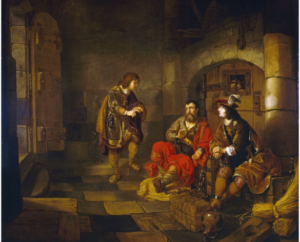Object of the Month: April 2013
Joseph Interpreting the Dreams of Pharaoh’s Butler and Baker
Oil on canvas, signed and dated, 1643
Gerbrand van den Eeckhout
Dutch, 1621–1674
Gerbrand van den Eeckhout, the son of a goldsmith, studied with Rembrandt for five years (age 15-20) and was a “great friend” of the famous artist, according to his biographer. He also continued to imitate his teacher’s style throughout his career, especially in his religious paintings. His first signed painting is dated 1641 (age 20), which probably indicates the time he advanced from student to independent artist. Therefore the Museum & Gallery’s painting, dated 1643, was one of his earliest works. In addition to painting, he worked as an etcher and draughtsman. He never lost interest in his father’s work of goldsmithing, often including precisely painted metal objects in his paintings, as well as producing a book of patterns for ornamental designs for metalworkers. His family’s Mennonite faith influenced his preference for religious subject matter, although he was also known for portraiture and landscape painting.
The biblical story of Joseph is an inspiring one. After being sold into slavery by his jealous brothers and being falsely accused of attempted rape in Egypt, the depicted scene shows him in prison. Because of his trustworthiness, he has been placed in a position of leadership within the prison (notice the keys hanging from his waist) and is interpreting the dreams of two of Pharaoh’s servants. The butler (or person who tasted the king’s wine to make sure it was not poisoned) is shown to the right in fancier clothes with a jug at his feet; he would be pardoned in three days. The baker, however, would be killed in three days. We can see the look of despondency on his face as he learns his fate. Although the butler promised to remember Joseph to Pharaoh, it wasn’t until two years later that a circumstance caused him to remember. After all of Joseph’s trials, he praised God and told his brothers, “you meant evil against me, but God meant it for good” (Genesis 50:20).
The provenance, or ownership history, of the painting begins with a sale in Amsterdam in 1762, just a little over 100 years after its creation. The Dundas family of Scotland purchased it, where it remained by family descent until 1953; it became part of the Collection in 1963.
Published in 2013
